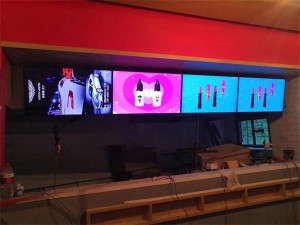Solution to chromatic aberration of LCD splicing screen
Many customers have more or less such problems when purchasing LCD splicing screens. How to solve the chromatic aberration problem of LCD splicing screen? LCD splicing screens have been widely used in various industries, but LCD splicing walls still have chromatic aberration problems. Generally, the color difference of the LCD splicing screen is mainly reflected in the inconsistency of the brightness and chromaticity of the screen, that is, a certain part of the screen is particularly bright or dark or other conditions. Based on these problems, Rongda Caijing LCD splicing screen manufacturers are here to share the chromatic aberration problems of LCD splicing screens and their solutions today!
Causes of chromatic aberration of LCD splicing screen
Chromatic aberration: Chromatic aberration, also known as chromatic aberration, is a serious defect in lens imaging. Color difference is simply the difference in color. When polychromatic light is used as the light source, monochromatic light will not produce chromatic aberration. The wavelength range of visible light is about 400-700 nanometers. Different wavelengths of light have different colors, and have different refractive indexes when passing through the lens, so that a point on the object side may form a color point on the image side. Chromatic aberration generally includes positional chromatic aberration and magnification chromatic aberration. Positional chromatic aberration causes color spots or halos to appear when the image is viewed at any position, making the image blurry, and magnifying chromatic aberration makes the image appear colored edges. The main function of the optical system is to eliminate chromatic aberration.
The inconsistency of the brightness and chroma of the splicing screen will result in poor brightness and chroma of the screen, usually indicating that a certain part of the screen is particularly bright or particularly dark, which is the so-called mosaic and blurry phenomenon.
Individually, the reasons for the difference in brightness and color are mainly due to the inherent discreteness of the physical characteristics of the LEDs, that is, due to the manufacturing process, the photoelectric parameters of each LED may not be the same, even in the same batch, the brightness may be 30 %-50% deviation, the wavelength difference generally reaches 5nm.
Because the LED is a self-luminous body. And the luminous intensity is proportional to the current supplied to it within a certain range. Therefore, in the process of circuit design, manufacturing, installation and debugging, the brightness difference can be minimized by reasonably controlling the driving current. Calculate with the average value as the standard value. Should be less than 15%-20%.
The solution of LCD splicing screen chromatic aberration
We talked about the causes of chromatic aberration of LCD splicing screens. So, if LCD splicing screens have chromatic aberrations in use, how should they be solved?
The biggest problem faced by LCD splicing products is to present different colors of LCD splicing. Usually when dealing with color difference issues, technicians have to adjust dozens of displays one by one, which not only takes time and effort, but also faces many problems, such as lack of a unified color reference standard, fatigue of visual recognition, and color performance effects of different displays. Different and many other problems. As a result, time and manpower are often exhausted, but the color difference problem of spliced displays still exists.
The wavelength difference between LEDs, the wavelength is a fixed optical parameter, which cannot be changed in the future. Therefore, it can be said that the chromatic aberration is caused by the differences in the photoelectric and physical characteristics between individual LEDs. As long as LEDs with small enough differences are used on the display, the color difference problem can be completely solved.
Solution 2. Carry out spectroscopy and color separation screening (mostly use professional spectroscopy and color separation machines). Practice proved. The effect of screening in this way is very good.
The above is the chromatic aberration problem and solution of the LCD splicing screen shared by Rongda Caijing, which not only effectively controls the chromatic aberration. And through the sorting of light intensity under the same voltage (or current). Meet the requirements of brightness consistency.
